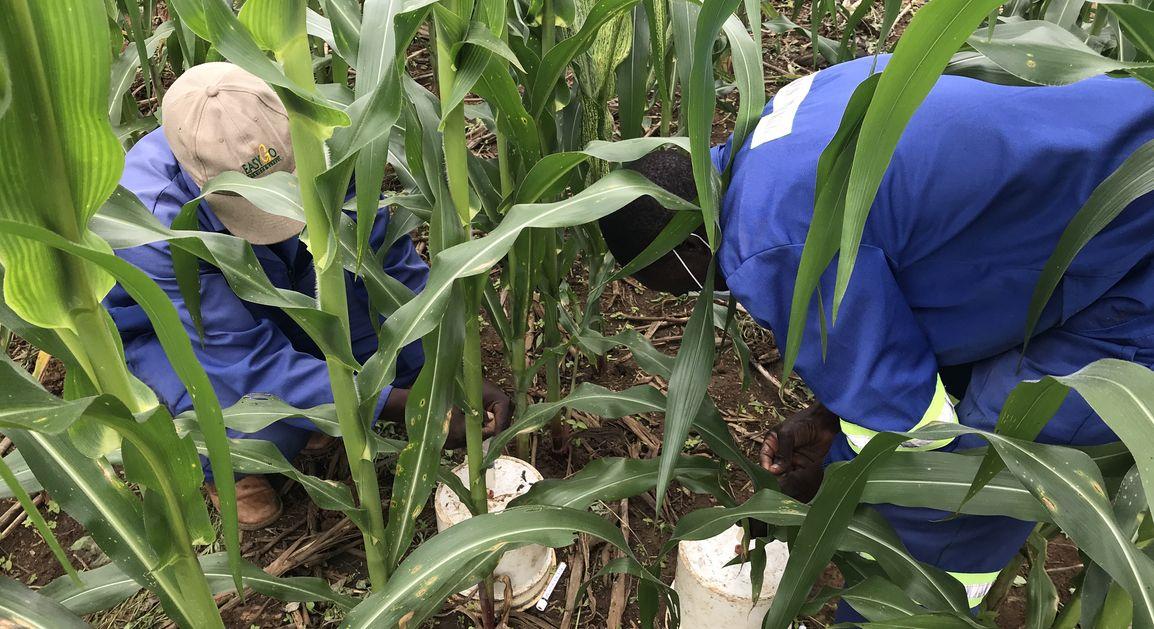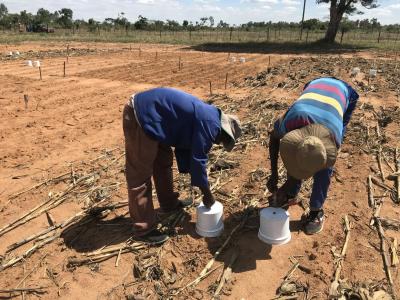Results & impact 10 October 2025
- Home
- Press area
- Press releases
- Agroecological intensification in Africa, nitrogen and GHG
Agroecological intensification in Africa and climate | Promising results in Zimbabwe

Trials on maize crops in Zimbabwe have shown the limited impact of increased nitrogen fertilization on emissions of nitrous oxide, a powerful greenhouse gas © R. Cardinael, CIRAD
The agricultural, forestry and other land use (AFOLU) sector accounted for 81% of anthropogenic emissions of nitrous oxide (N2O) – a powerful GHG – over the period 2007-2016. The IPCC is quite clear on this: such emissions are primarily the result of nitrogen fertilizer use.
Might some agricultural soil conservation practices serve to limit GHG emissions when growing maize? To answer that question, an international team (CIRAD, University of Zimbabwe, ETH Zürich and CIMMYT) assessed GHG emissions at two long-term experimental sites run by CIMMYT in Zimbabwe. The result was unexpected: cumulated N2O emissions were very low (between 150 and 400 g of N2O per hectare per year), despite the fact that the fertilizer rate applied (60 kg of nitrogen/ha/year) was three times higher than that generally used in the region (which uses almost ten times less nitrogen fertilizer than Europe). This was the case irrespective of the farming practices used.
Boosting yields to reduce agricultural land use
"Our study showed that it is possible to increase fertilizer rates in the region to boost yields, without pushing up nitrous oxide emissions, which have an adverse effect on climate", says Armwell Shumba, a PhD student at the University of Zimbabwe and CIRAD and the study's lead author.
"This has major implications, because in sub-Saharan Africa, yields are often limited more by poor soil nutrient availability than by rainfall", Rémi Cardinael, an agricultural soils specialist with CIRAD who is coordinating the DSCATT project in Zimbabwe, adds. "It is vital to increase yields per hectare, to prevent carbon- and biodiversity-rich natural ecosystems being converted to agricultural use in response to population growth."
In addition to the potential consequences for farmers, the study also showed that N2O emissions linked to mineral fertilizer use are overestimated in national GHG inventories. "If data from in situ measurements are not available, GHG emissions are estimated based on IPCC default emission factors", Rémi Cardinael explains. "And our study showed that those factors are overestimated for the context in Africa."
Increasing nitrogen fertilizer rates while reducing the risk of losses into the environment
As regards the initial aim of the study – to assess agricultural soil conservation practices – the results are less clear cut. "We observed that N2O emissions depend strongly on the interaction between farming practices, soil type (sandy or clay) and rainfall over the year", Rémi Cardinael explains. In the first year of the trial, the highest N2O emissions were seen with mulch treatments on sandy soils and rotation with legumes on clay soils. However, no difference was observed the following year, notably due to the very different rainfall, which caused nitrogen losses through leaching rather than through N2O emissions.
The maize plots were fertilized at the best possible time, with three staggered applications as close as possible to the root system. "Farmers should always observe the 4Rs (right source, right time, right place and right rate) to maximize fertilizer efficacy and minimizing losses into the environment", Armwell Shumba stresses. Local farmers generally do so.
Work is ongoing to determine the climate impact
"These results are novel, because there has been little work on the topic in Africa", says Rémi Cardinael. This type of study takes both time and effort, since GHG emissions have to be monitored across the entire year, and more frequently in the event of fertilizer applications or heavy rain.
The team is now working to determine the climate impact of different farming practices: soil carbon storage and CO2 flux (DSCATT project), and the bio-geophysical effects, such as changing albedo (RAIZ project), are currently being assessed. The impact of extreme weather events (droughts and floods) on the nitrogen cycle and GHG emissions (IntercropValuES and RAIZ projects) is also under study.
Methane (CH4) emissions were also measured. While clay soils proved to be a methane sink (around -500 g CH4/ha/year), sandy soils (lixisol) were a major source of methane (almost 700 g CH4/ha/year). "Tropical soils are generally seen as CH4 sinks rather than sources", Rémi Cardinael says. "We need measurements from other sites, since lixisols are very common in Zimbabwe. This could have substantial consequences for the climate."
Reference
Shumba Armwell, Chikowo Régis, Corbeels Marc, Six Johan, Thierfelder Christian, Cardinael Rémi. 2023. Long-term tillage, residue management and crop rotation impacts on N2O and CH4 emissions from two contrasting soils in sub-humid Zimbabwe. Agriculture, Ecosystems and Environment, 341:108207




























